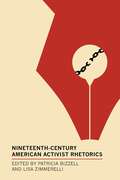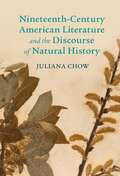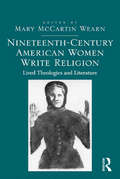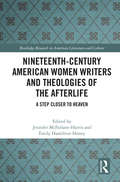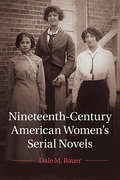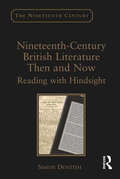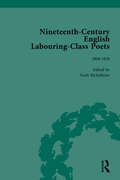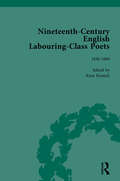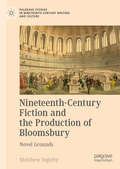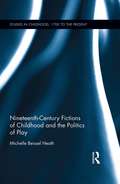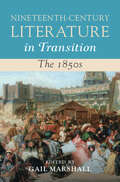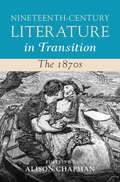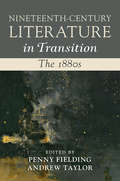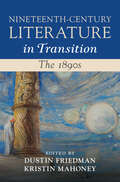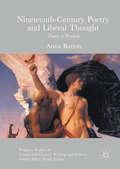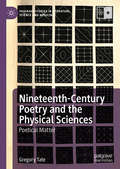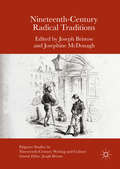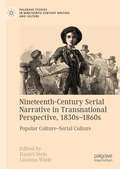- Table View
- List View
Nineteenth-Century American Activist Rhetorics
by Patricia Bizzell and Lisa ZimmerelliIn the nineteenth century the United States was ablaze with activism and reform: people of all races, creeds, classes, and genders engaged with diverse intellectual, social, and civic issues. This cutting-edge, revelatory book focuses on rhetoric that is overtly political and oriented to social reform. It not only contributes to our historical understanding of the period by covering a wide array of contexts--from letters, preaching, and speeches to labor organizing, protests, journalism, and theater by white and Black women, Indigenous people, and Chinese immigrants--but also relates conflicts over imperialism, colonialism, women's rights, temperance, and slavery to today's struggles over racial justice, sexual freedom, access to multimodal knowledge, and the unjust effects of sociopolitical hierarchies. The editors' introduction traces recent scholarship on activist rhetorics and the turn in rhetorical theory toward the work of marginalized voices calling for radical social change.
Nineteenth-Century American Literature and the Discourse of Natural History (Cambridge Studies in American Literature and Culture)
by Juliana ChowNineteenth-Century American Literature and the Discourse of Natural History illuminates how literary experimentation with natural history provides penumbral views of environmental survival. The book brings together feminist revisions of scientific objectivity and critical race theory on diaspora to show how biogeography influenced material and metaphorical concepts of species and race. It also highlights how lesser known writers of color like Simon Pokagon and James McCune Smith connected species migration and mutability to forms of racial uplift. The book situates these literary visions of environmental fragility and survival amidst the development of Darwinian theories of evolution and against a westward expanding American settler colonialism.
Nineteenth-Century American Women Write Religion: Lived Theologies and Literature
by Mary McCartin WearnNineteenth-century American women’s culture was immersed in religious experience and female authors of the era employed representations of faith to various cultural ends. Focusing primarily on non-canonical texts, this collection explores the diversity of religious discourse in nineteenth-century women’s literature. The contributors examine fiction, political writings, poetry, and memoirs by professional authors, social activists, and women of faith, including Elizabeth Stuart Phelps, Angelina and Sarah Grimké, Louisa May Alcott, Rebecca Harding Davis, Harriet E. Wilson, Sarah Piatt, Julia Ward Howe, Julia A. J. Foote, Lucy Mack Smith, Rebecca Cox Jackson, and Fanny Newell. Embracing the complexities of lived religion in women’s culture-both its repressive and its revolutionary potential-Nineteenth-Century American Women Write Religion articulates how American women writers adopted the language of religious sentiment for their own cultural, political, or spiritual ends.
Nineteenth-Century American Women Writers and Theologies of the Afterlife: A Step Closer to Heaven (Routledge Research in American Literature and Culture)
by Jennifer McFarlane-HarrisThis collection analyzes the theme of the "afterlife" as it animated nineteenth-century American women’s theology-making and appeals for social justice. Authors like Harriet Beecher Stowe, Elizabeth Stuart Phelps, Martha Finley, Jarena Lee, Maria Stewart, Zilpha Elaw, Rebecca Cox Jackson, Catherine Maria Sedgwick, Elizabeth Palmer Peabody, Belinda Marden Pratt, and others wrote to have a voice in the moral debates that were consuming churches and national politics. These texts are expressions of the lives and dynamic minds of women who developed sophisticated, systematic spiritual and textual approaches to the divine, to their denominations or religious traditions, and to the mainstream culture around them. Women do not simply live out theologies authored by men. Rather, Nineteenth-Century American Women Writers and Theologies of the Afterlife: A Step Closer to Heaven is grounded in the radical notion that the theological principles crafted by women and derived from women’s experiences, intellectual habits, and organizational capabilities are foundational to American literature itself.
Nineteenth-Century American Women's Serial Novels (Cambridge Studies in American Literature and Culture #183)
by Dale M. BauerNineteenth-Century American Women's Serial Novels explores the prolific careers of four exemplary novelists - E. D. E. N. Southworth, Ann Stephens, Mary Jane Holmes, and Laura Jean Libbey. These commercially successful writers helped to shape the popular tradition of serial magazine fiction by drawing on readers' tastes along with their cultural concerns. Their astonishing productivity led magazine editors and publishers to return to them repeatedly for more serials to be turned into even more novels, even as they reprinted these fictions under new titles. Dale M. Bauer analyzes how serials deployed the repetition of plots and the traumas representing the sources of women's anxieties and pain. Arguing that these novels provided temporary resolutions to the social, economic, and psychological tensions that readers faced, Bauer explains how this otherwise forgotten archive of fiction now offers an extraordinarily expanded range of women's literary effort from the nineteenth to the twentieth century.
Nineteenth-Century British Literature Then and Now: Reading with Hindsight (The Nineteenth Century Series)
by Simon DentithEnvisioning today’s readers as poised between an impossible attempt to read texts as their original readers experienced them and an awareness of our own temporal moment, Simon Dentith complicates traditional prejudices against hindsight to approach issues of interpretation and historicity in nineteenth-century literature. Suggesting that the characteristic aesthetic attitude encouraged by the backward look is one of irony rather than remorse or regret, he examines works by Charles Dickens, George Eliot, Anthony Trollope, William Morris and John Ruskin in terms of their participation in significant histories that extend to this day. Liberalism, class, gender, political representation and notions of progress, utopianism and ecological concern as currently understood can be traced back to the nineteenth century. Just as today’s critics strive to respect the authenticity of nineteenth-century writers and readers who responded to these ideas within their historical world, so, too, do those nineteenth-century imaginings persist to challenge the assumptions of the present. It is therefore possible, Dentith argues, to conceive of the act of reading historical literature with an awareness of the historical context and of the difference between the past and the present while allowing that friction or difference to be part of how we think about a text and how it communicates. His book summons us to consider how words travel to the reality of the reader’s own time and how engagement with nineteenth-century writers’ anticipation of the judgements of future generations reveal hindsight’s capacity to transform our understanding of the past in the light of subsequent knowledge.
Nineteenth-Century Energies: Literature, Technology, Culture
by Lynn VoskuilNineteenth-Century Energies explores the idea of ‘energy’, a concept central to new directions in interdisciplinary studies today. It examines the cultural perceptions and uses of energy in the nineteenth century – both in terms of pure and applied science, and as an idea with widespread diffusion in the popular imagination – in contributions by scholars drawing on a variety of fields, such as literature, philosophy, history, French studies, Latin American studies, cinema studies, and art history. These contributions explore the rise of insomnia as a recognized ailment, the role of guns and gun culture in the perception of human agency, the first uses of the barometer to predict massive cyclonic weather systems, and the hallucinatory, almost occult effects of radiant energy in early film. Exemplifying innovative research in twenty-first century academia, this volume also speaks to the wider cultural concerns of today’s global citizen about the preservation and renewal of natural resources around the world; the emergence of devices and technologies that have both improved and impaired human life; the aggrandizement of nation-states around large technological systems; and the centrality of the image in our perception and absorption of contemporary culture. This book was originally published as a special issue of Nineteenth-Century Contexts.
Nineteenth-Century English Labouring-Class Poets Vol 1
by John GoodridgeOver 100 poets of labouring class origin were published in Britain in the 18th and 19th centuries. Some were hugely popular and important in their day but few are available today. This is a collection of some of those poems from the 19th century.
Nineteenth-Century English Labouring-Class Poets Vol 2
by John GoodridgeOver 100 poets of labouring class origin were published in Britain in the 18th and 19th centuries. Some were hugely popular and important in their day but few are available today. This is a collection of some of those poems from the 19th century.
Nineteenth-Century English Labouring-Class Poets Vol 3: 1830-1860
by John GoodridgeOver 100 poets of labouring class origin were published in Britain in the 18th and 19th centuries. Some were hugely popular and important in their day but few are available today. This is a collection of some of those poems from the 19th century.
Nineteenth-Century Fiction and the Production of Bloomsbury: Novel Grounds (Palgrave Studies In Nineteenth-century Writing And Culture )
by Matthew InglebyThis study explores the role of fiction in the social production of the West Central district of London in the nineteenth century. It tells a new history of the novel from a local geographical perspective, tracing developments in the form as it engaged with Bloomsbury in the period it emerged as the city’s dominant literary zone. A neighbourhood that was subject simultaneously to socio-economic decline and cultural ascent, fiction set in Bloomsbury is shown to have reconceived the area’s marginality as potential autonomy. Drawing on sociological theory, this book critically historicizes Bloomsbury’s trajectory to show that its association with the intellectual “fraction” known as the ‘Bloomsbury Group’ at the beginning of the twentieth century was symptomatic rather than exceptional. From the 1820s onwards, writers positioned themselves socially within the metropolitan geography they projected through their fiction. As Bloomsbury became increasingly identified with the cultural capital of writers rather than the economic capital of established wealth, writers subtly affiliated themselves with the area, and the figure of the writer and Bloomsbury became symbolically conflated.
Nineteenth-Century Fictions of Childhood and the Politics of Play (Studies in Childhood, 1700 to the Present)
by Michelle Beissel HeathDrawing evidence from transatlantic literary texts of childhood as well as from nineteenth and early twentieth century children’s and family card, board, and parlor games and games manuals, Nineteenth-Century Fictions of Childhood and the Politics of Play aims to reveal what might be thought of as "playful literary citizenship," or some of the motivations inherent in later nineteenth and early twentieth century Anglo-American play pursuits as they relate to interest in shaping citizens through investment in "good" literature. Tracing play, as a societal and historical construct, as it surfaces time and again in children’s literary texts as well as children’s literary texts as they surface time and again in situations and environments of children’s play, this book underscores how play and literature are consistently deployed in tandem in attempts to create ideal citizens – even as those ideals varied greatly and were dependent on factors such as gender, ethnicity, colonial status, and class.
Nineteenth-Century Italian Women Writers and the Woman Question: The Case of Neera (Routledge Focus on Literature)
by Catherine Ramsey-PortolanoNineteenth-Century Italian Women Writers and the Woman Question focuses on the literary, journalistic and epistolary production of Italian woman writer Neera, pseudonym for Anna Radius Zuccari, one of the most prolific and successful women writers of late nineteenth-century Italy. This study proposes to bring Neera out of the shadows of literary marginality to which she has long been confined by analyzing her contribution to literary and cultural debates as testimony to the pivotal role she played in the creation of a female literary voice within the Italian fin-de-siècle context. Drawing from the Anglo-American feminist critical tradition; modern Italian feminist theory on the maternal order and sexual difference; and a close reading of Neera’s literary, theoretical and epistolary writings this volume examines Neera’s work from a three-pronged perspective: as promoter of a maternal order in contrast to the existent paternal order, as one of few women writers to participate actively in Italy’s verismo movement and as epistolary correspondent of leading representatives within fin-de-siècle Italian literary and journalistic circles. Nineteenth-Century Italian Women Writers and the Woman Question represents the first monographic volume in English dedicated exclusively to this important Italian woman writer, repositioning her within the Italian literary landscape and canon.
Nineteenth-Century Literature in Transition: The 1830s (Nineteenth-Century Literature in Transition)
by John Gardner David StewartThis instalment in the Nineteenth-Century Literature in Transition series concerns a decade that was as technologically transitional as it was eventful on a global scale. It collects work from a group of internationally renowned scholars across disciplinary boundaries in order to engage with the wide array of cultural developments that defined the 1830s. Often overlooked as a boundary between the Romantic and Victorian periods, this decade was, the book proposes, the central pivot of the nineteenth century. Far from a time of peaceful reform, it was marked by violent colonial expansion, political resistance, and revolutionary technologies such as the photograph, the expansion of steam power, and the railway that changed the world irreversibly. Contributors explore a flurry of cultural forms to take the pulse of the decade, from Silver Fork fiction to lithography, from working-class periodicals to photographs, and from urban sketches to magazine fiction.
Nineteenth-Century Literature in Transition: The 1850s (Nineteenth-Century Literature in Transition)
by Gail MarshallEstablishing a fresh critical paradigm, this volume shows how the 1850s was significantly defined by forms of increasing intellectual, class, and geographical mobility. It saw the flourishing of major Victorian writers, including George Eliot, Elizabeth Gaskell, Charles Dickens, W. M. Thackeray, Matthew Arnold, Charles Kingsley, Anthony Trollope, Tennyson, and Elizabeth Barrett and Robert Browning. Outputs by these writers were read alongside a variety of other genres, including travel writings, learned society reports, statistical returns, popular journalism, working-class writing, and scientific papers in a period which saw an increasing availability of cheap printed matter. Intertextuality and interdisciplinarity are not only key to this volume, but are also one of the most important legacies of the literature of the 1850s. Contributors are attentive to a plethora of voices, disciplines, and forms of knowledge which they read through rigorous 21st-century critical priorities including diversity, cultural and physical geography, and the environment.
Nineteenth-Century Literature in Transition: The 1860s (Nineteenth-Century Literature in Transition #Series Number 7)
by Pamela K. GilbertOffering an in-depth overview and reappraisal of the 1860s in British literature, this innovative volume features in-depth analyses from noted scholars at the tops of their fields. Covering characteristic literary genres of the 1860s (including sensation and lyric, as well as Golden Age children's literature), and topics of current and enduring interest in the field, from empire and slavery to evolution, environmental issues and economics, it incorporates drama as well as poetry and fiction, and emphasizes the history of publishing and periodicals so important to the period. Chapters are attentive to the global context, from Ireland on the stage, to Bengali literature, to Britain's muted response to the US Civil War. The Introduction gives an overview that places these individual chapters in the historical context of the 1860s, as well as the current scholarly conversation in the field.
Nineteenth-Century Literature in Transition: The 1870s (Nineteenth-Century Literature in Transition)
by Alison ChapmanThe 1870s were defined by cultural confidence, moral superiority, and metropolitan elitism. This volume examines and unsettles a decade closely associated with 'High Victorianism' and the popular emergence of 'Victorian' as a term for the epoch and its literature. Writers active in the 1870s were self-conscious about contemporary claims to modernity, reform, and progress, themes which they explored through conversation, conflict, and innovation, often betraying uncertainty about their era. The chapters in this volume cover a broad range of canonical and lesser known British and colonial writers, including George Eliot, Alfred Lord Tennyson, the Rossettis, Emily Pfeiffer, John Ruskin, Edward Lear, Lewis Carroll, Ellen Wood, Toru Dutt, Antony Trollope, Dinah Craik, Susan K. Phillips, Thomas Hardy, and Rolf Boldrewood. Together they offer a variety of methodologies for a pluralist literary history, including approaches based on feminism, visual cultures, digital humanities, and the history of narrative and poetic genres.
Nineteenth-Century Literature in Transition: The 1880s (Nineteenth-Century Literature in Transition)
by Andrew Taylor Penny FieldingWhat does it mean to focus on the decade as a unit of literary history? Emerging from the shadows of iconic Victorian authors such as Eliot and Tennyson, the 1880s is a decade that has been too readily overlooked in the rush to embrace end-of-century decadence and aestheticism. The 1880s witnessed new developments in transatlantic networks, experiments in lyric poetry, the decline of the three-volume novel, and the revaluation of authors, journalists and the reading public. The contributors to this collection explore the case for the 1880s as both a discrete point of literary production, with its own pressures and provocations, and as part of literature's sense of its expanded temporal and geographical reach. The essays address a wide variety of authors, topics and genres, offering incisive readings of the diverse forces at work in the shaping of the literary 1880s.
Nineteenth-Century Literature in Transition: The 1890s (Nineteenth-Century Literature in Transition)
by Kristin Mahoney Dustin FriedmanThe 1890s were once seen as marginal within the larger field of Victorian studies, which tended to privilege the realist novel and the authors of the mid-century. In recent decades, the fin de siècle has come to be viewed as one of the most dynamic decades of the Victorian era. Viewed by writers and artists of the period as a moment of opportunity, transition, and urgency, the 1890s are pivotal for understanding the parameters of the field of Victorian studies itself. This volume makes a case for why the decade continues to be an area of perennial fascination, focusing on transnational connections, gender and sexuality, ecological concerns, technological innovations, and other current critical trends. This collection both calls attention to the diverse range of literature and art being produced during this period and foregrounds the relevance of the Victorian era's final years to issues and crises that face us today.
Nineteenth-Century Narratives of Contagion: 'Our Feverish Contact' (Routledge Studies in Nineteenth Century Literature #Vol. 1)
by Allan Conrad ChristensenThis intriguing book examines the ways contagion - or disease - inform and shape a wide variety of nineteenth century texts and contexts. Christiensen dissects the cultural assumptions concerning disease, health, impurity and so on before exploring different perspectives on key themes such as plague, nursing and the hospital environment and focusing on certain key texts including Dicken's Bleak House, Gaskell's Ruth, and Zola's Le Docteur Pascal.
Nineteenth-Century Poetry and Liberal Thought
by Anna BartonThis book explores the relationship between nineteenth-century poetry and liberal philosophy. It carries out a reassessment of the aesthetic possibilities of liberalism and it considers the variety of ways that poetry by William Wordsworth, Elizabeth Barrett Browning, Arthur Hugh Clough, George Meredith, Robert Browning, Matthew Arnold and Algernon Charles Swinburne responds to and participates in urgent philosophical, social and political debates about liberty and the rule of law. It provides an account of poetry's intervention into four different sites where liberalism has a stake: the self, the university, married life and the nation state and it seeks to assert the peculiar capacity of poetry to articulate liberal concerns, proposing poetic language as a means of liberal enquiry.
Nineteenth-Century Poetry and the Physical Sciences: Poetical Matter (Palgrave Studies in Literature, Science and Medicine)
by Gregory TatePoetical Matter examines the two-way exchange of language and methods between nineteenth-century poetry and the physical sciences. The book argues that poets such as William Wordsworth, Mathilde Blind, and Thomas Hardy identified poetry as an experimental investigation of nature’s materiality. It also explores how science writers such as Humphry Davy, Mary Somerville, and John Tyndall used poetry to formulate their theories, to bestow cultural legitimacy on the emerging disciplines of chemistry and physics, and to communicate technical knowledge to non-specialist audiences. The book’s chapters show how poets and science writers relied on a set of shared terms (“form,” “experiment,” “rhythm,” “sound,” “measure”) and how the meaning of those terms was debated and reimagined in a range of different texts.“A stimulating analysis of nineteenth-century poetry and physics. In this groundbreakingstudy, Tate turns to sound to tease out fascinating continuities acrossscientific inquiry and verse. Reflecting that ‘the processes of the universe’ werethemselves ‘rhythmic,’ he shows that a wide range of poets and scientists werethinking through undulatory motion as a space where the material and the immaterialmet. ‘The motion of waves,’ Tate demonstrates, was ‘the exemplary form inthe physical sciences.’ Sound waves, light, energy, and poetic meter were eachcharacterized by a ‘process of undulation,’ that could be understood as both aphysical and a formal property. Drawing on work in new materialism and newformalism, Tate illuminates a nineteenth-century preoccupation with dynamic patterningthat characterizes the undulatory as (in John Herschel’s words) not ‘things,but forms.’”—Anna Henchman, Associate Professor of English at Boston University, USA“This impressive study consolidates and considerably advances the field of physicsand poetry studies. Moving easily and authoritatively between canonical and scientistpoets, Nineteenth-Century Poetry and the Physical Sciences draws scientificthought and poetic form into telling relation, disclosing how they were understoodvariously across the nineteenth century as both comparable and competingways of knowing the physical world. Clearly written and beautifully structured,Nineteenth-Century Poetry and the Physical Sciences is both scholarly and accessible,a fascinating and indispensable contribution to its field.”—Daniel Brown, Professor of English at the University of Southampton, UK“Essential reading for Victorianists. Tate’s study of nineteenth-century poetry andscience reconfi gures debate by insisting on the equivalence of accounts ofempirical fact and speculative theory rather than their antagonism. Theundulatory rhythms of the universe and of poetry, the language of science and ofverse, come into new relations. Tate brilliantly re-reads Coleridge, Tennyson,Mathilde Blind and Hardy through their explorations of matter and ontologicalreality. He also addresses contemporary theory from Latour to Jane Bennett.” — Isobel Armstrong, Emeritus Professor of English at Birkbeck, University of London, UK
Nineteenth-Century Radical Traditions
by Joseph Bristow Josephine McdonaghThis book takes a fresh look at the progressive interventions of writers in the nineteenth century. From Cobbett to Dickens and George Eliot, and including a host of lesser known figures - popular novelists, poets, journalists, political activists - writers shared a commitment to exploring the potential of literature as a medium in which to imagine new and better worlds. The essays in this volume ask how we should understand these interventions and what are their legacies in the twentieth and twenty first centuries? Inspired by the work of the radical literary scholar, the late Sally Ledger, this volume provides a commentary on the political traditions that underpin the literature of this complex period, and examines the interpretive methods that are needed to understand them. This timely book contributes to our appreciation of the radical traditions that underpin our literary past.
Nineteenth-Century Serial Narrative in Transnational Perspective, 1830s−1860s: Popular Culture—Serial Culture (Palgrave Studies in Nineteenth-Century Writing and Culture)
by Daniel Stein Lisanna WieleThis volume examines the emergence of modern popular culture between the 1830s and the 1860s, when popular storytelling meant serial storytelling and when new printing techniques and an expanding infrastructure brought serial entertainment to the masses. Analyzing fiction and non-fiction narratives from the United States, France, Great Britain, Germany, Austria, Turkey, and Brazil, Popular Culture—Serial Culture offers a transnational perspective on border-crossing serial genres from the roman feuilleton and the city mystery novel to abolitionist gift books and world’s fairs.
Nineteenth-Century Southern Women Writers: Grace King and Modernism (Routledge Studies in Nineteenth Century Literature)
by Melissa Walker Heidari Brigitte ZauggThe essays in this book explore the role of Grace King’s fiction in the movement of American literature from local color and realism to modernism and show that her work exposes a postbellum New Orleans that is fragmented socially, politically, and linguistically. In her introduction, Melissa Walker Heidari examines selections from King’s journals and letters as views into her journey toward a modernist aesthetic—what King describes in one passage as "the continual voyage I made." Sirpa Salenius sees King’s fiction as a challenge to dominant conceptualizations of womanhood and a reaction against female oppression and heteronormativity. In his analysis of "An Affair of the Heart," Ralph J. Poole highlights the rhetoric of excess that reveals a social satire debunking sexual and racial double standards. Ineke Bockting shows the modernist aspects of King’s fiction through a stylistic analysis which explores spatial, temporal, biological, psychological, social, and racial liminalities. Françoise Buisson demonstrates that King’s writing "is inspired by the Southern oral tradition but goes beyond it by taking on a theatrical dimension that can be quite modern and even experimental at times." Kathie Birat claims that it is important to underline King’s relationship to realism, "for the metonymic functioning of space as a signifier for social relations is an important characteristic of the realist novel." Stéphanie Durrans analyzes "The Story of a Day" as an incest narrative and focuses on King’s development of a modernist aesthetics to serve her terrifying investigation into social ills as she probes the inner world of her silent character. Amy Doherty Mohr explores intersections between regionalism and modernism in public and silenced histories, as well as King’s treatment of myth and mobility. Brigitte Zaugg examines in "The Little Convent Girl" King’s presentation of the figure of the double and the issue of language as well as the narrative voice, which, she argues, "definitely inscribes the text, with its understatement, economy and quiet symbolism, in the modernist tradition." Miki Pfeffer closes the collection with an afterword in which she offers excerpts from King’s letters as encouragement for "scholars to seek Grace King as a primary source," arguing that "Grace King’s own words seem best able to dialogue with the critical readings herein." Each of these essays enables us to see King’s place in the construction of modernity; each illuminates the "continual voyage" that King made.
